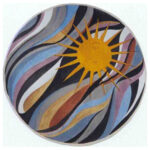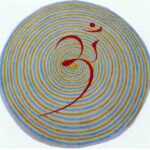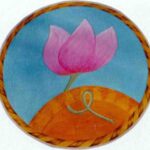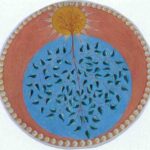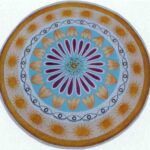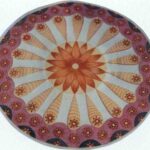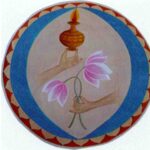Director’s paintings
The paintings were made in 70’s and 80’s when folk art was not so well known. It was limited to the wall and floor in villagers. Not much printed material was available at that time. I saw them at site and roughly copied them on paper. Then I collected the themes and made a final painting in my leisure time. I was thus able to bring the real and genuine folk style, particular to the area, picked up straight from the site-the wall, floor or the pujaghar and sometimes from printed material. The paintings gives a real feel of genuine folk art and culture of the area.
“Sudha Satyawadi”
Director With Bushman Artists of Botswana
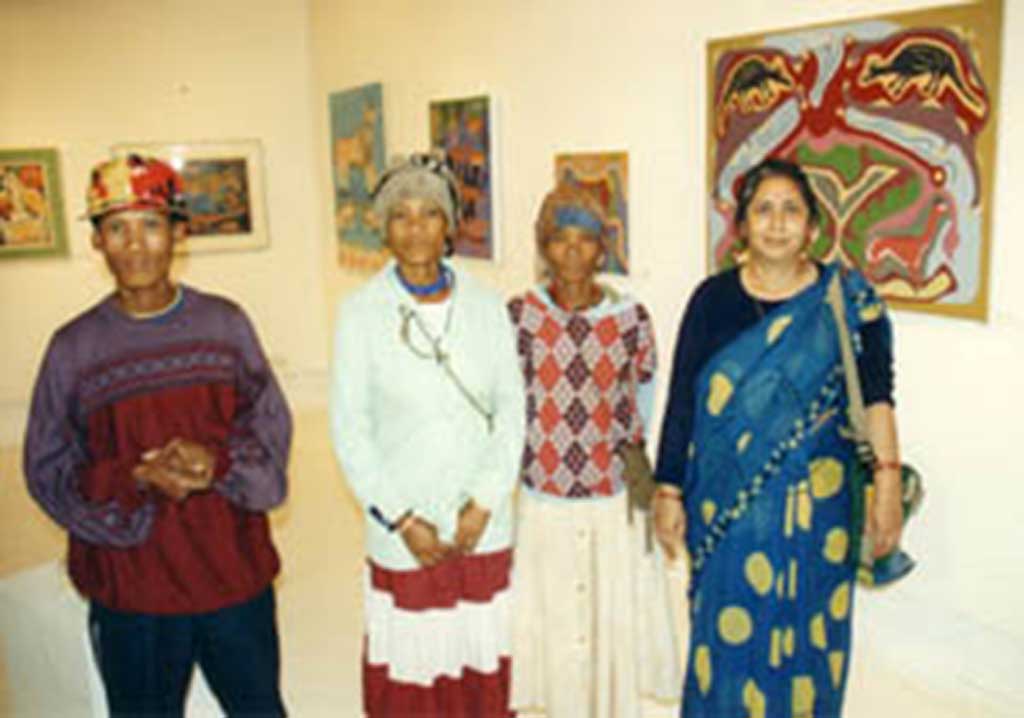
| Vedic Philosophy | Ritu chkra | Ajanta | Animals | Dance performence | Madhubani | Tanjavor | Others |
Vedic paintings
The drive to search for the mysterious source of life and cosmic creation out of which the universe emerged is a question that has remained unsolved and the ideas and links the various mythic and philosophical versions. There are many variants of the history of creation and many metaphors described by the indescribable Absolute. The concept of creation and of Absolute finds expression at the village level too through symbols and my
Vedas or ancient scriptures constitute a blueprint of creation. Vedic philosophy covers a wide spectrum of subjects: Starting from Brahma, the ultimate and Supreme Reality and architect of the universe, he is also the starter of cosmic order, from the broad purpose of human existence to the details of good thoughts and good deeds. The philosophy extends from the purpose of human existence to details of good thoughts and deeds almost in a prescriptive mode. The ideas have been represented through vedic symbols.
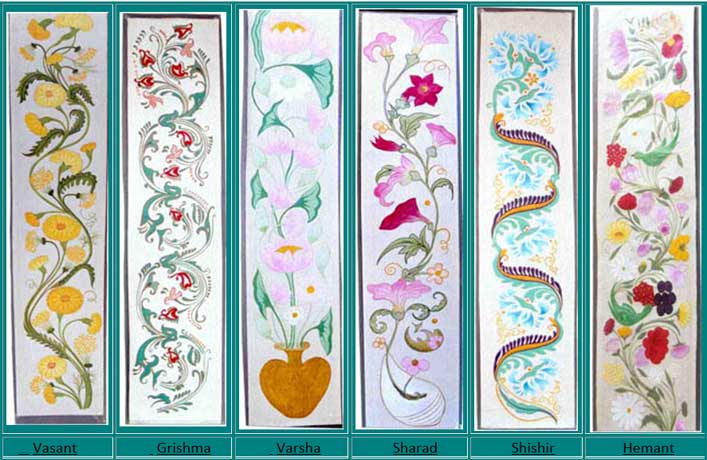
The orderliness or the rhythm of the universe set by the Supreme Reality is called Rta. One manifestation of this rta is the seasons or ritu. The change of seasons is regarded by all as something more than a phenomenon of nature. It is an occasion to rejoice. Each season is welcomed with celebrations and festivities, songs and dances. This is more so in villages.There are celebrations at sowing and harvesting time. The advent of winter, spring as also rainy season is celebrated with songs, dances and rituals. In India there are six seasons. In each of these nature adorns itself with a variety of colours. The symphony of colours of different seasons has been captured in the paintings.
Dance
In India dance is considered a form of worship. There is an interesting myth about how dance performance started. The gods were bored with routine heavenly activities. So they sent Indra to request Brahma to write a play in which they could see, hear and understand the real nature of joy. Brahma therefore started to write a Veda, known as the fifth Veda or Natyaveda, for which he extracted parts from other Vedas. He took recitation from the Rigveda, song, mime and rasa respectively from the Sama, Yajur and the Atharvaveda. Thus was created the Natyaveda, the Veda of theatre. Then Brahma called upon Viswa karma, the vastukar or divine architect, to build a theatre in Indra’s heaven.
When the theatre was completed, sage Bharata took over the production of the play. Siva was the dance artist who performed the famous tandava nrtya which symbolises the motion of cosmos. Parvati, his wife performed the lasya dance. Vishnu also gave a performance. The play was such a success that Bharata was asked to bring the knowledge of the Natyaveda down to the humans. Here he wrote the famous Bharatanatyashastra which means science of dances of Bharat, the document which is the source of all Indian dramas. A dance hall is therefore always constructed in a temple for a performance before the deity. Even today a dance before the deity usually constitutes a ritual as a part of the daily worship and prayer.
In India apart from dance before a deity, a group dance is performed on any joyous occasion, be it a marriage, change of season, harvest time, onset of rains, winter, spring and so on. Every region and every state of India has its own dances. The diversity of the Indian subcontinent is seen in the abundance of a variety in dances.
Preparation For Dance
Nartaki was the favourite subject in ancient Indian art of painting and sculpture. Nartaki were painted on the wall of ancient palaces when the court scene of Indra in heaven is depicted. In Indian temples there is a tradition of providing a dance hall. The Indian dances as also the social and cultural ethos associated with the dancers and the profession of dance has evolved greatly over the centuries. Here Nartiki is preparing for dance performance.
Mural painting of Ajanta
Buddhist monks excavated rocks to form these caves for praying, for meditation and for residing. The serene natural surroundings of the area made Ajanta an ideal place for Buddhist monks to seek the “path” and for artisans to carve monuments dedicated to the Lord Buddha.
Few paintings from Ajanta murals :
Animals
Animals and birds have a life of their own in decorative folk art. The depiction of elephant, lion, bull, horse, monkey, peacock and duck provides a glorious example of artistic naturalism based on direct observation of life. In Hindu mythology, fish, tortoise, boar, lion (narasimha) are supposed to be the earliest incarnations of Vishnu
Madhubani Paintings
Madhubani paintings are created from house to house. Through them, religious symbolism is expressed. In Mithila, women folk of all communities paint. Madhubani paintings are primarily wall paintings like frescoes. Most famous are kohber paintings (marriage alpana). The central theme is love and fertility. Passion, love and desire are reduced to symbols to suggest and evoke mood, to create an atmosphere and environment. Paintings are done by ladies at home as a useful and absorbing past time.
Thanjavur Painting
These are from south India. The style was essentially of Tamil origin but it spread gradually to Andhra Pradesh and to Karnataka. This art is the product of artisans from traditional families. They were commissioned by devotees to make paintings of Hindu Gods mainly infant Krishna. This folk art is patronised by the affluent who have custom made paintings created which are adorned with gold and precious stones


